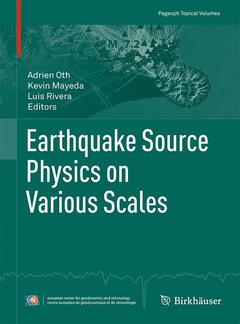Description
Earthquake Source Physics on Various Scales, 2015
Pageoph Topical Volumes Series
Coordinators: Oth Adrien, Mayeda Kevin, Rivera Luis
Language: English
Subject for Earthquake Source Physics on Various Scales:
330 p. · 19.3x26 cm · Paperback
Description
/li>Contents
/li>Comment
/li>
Earthquake rupture is a process of remarkable complexity. Over the past few decades, scientists have become aware of its high variability on all scales as well as its wide dynamic range. At the same time, a thorough understanding of the seismic source process is a key element of reliable earthquake ground motion prediction.
The present book contains a comprehensive collection of contributions originating from the 2012 ECGS Workshop Earthquake Source Physics on Various Scales, held in Luxembourg. The seventeen articles in this volume cover theoretical and observational aspects of the earthquake source process, ranging from tiny, laboratory-generated M -6 events to the source complexity and radiated energy of the world?s greatest earthquakes. Among other aspects, the papers provide new insights into the relationship of earthquake recurrence time with fault frictional parameters, how the results of lab-based friction experiments relate to observational source studies, and how geometrical source complexity can be quantified. In particular, several papers are devoted to the question whether small and large earthquakes scale self-similarly or if they show differences in their dynamic source characteristics, which is one of the most hotly debated aspects of modern seismology.
The volume provides an integrated view of the current state-of-the-art knowledge on the earthquake source process on all scales and will be useful to students and professional researchers who are interested in these phenomena.
Preface to the Topical Volume Earthquake Source Physics on Various Scales by Adrien Oth, Kevin Mayeda, Luis Rivera.- Linking the Recurrence Time of Earthquakes to Source Parameters: a Dream or a Real Possibility? by Andrea Bizzarri, Paola Crupi.- Slip-Weakening Models of the 2011 Tohoku-Oki Earthquake and Constraints on Stress Drop and Fracture Energy by Yihe Huang, Jean-Paul Ampuero, Hiroo Kanamori.- Foreshocks and b Value: Bridging Macroscopic Observations to Source Mechanical Considerations by M. Avlonitis, G. Papadopoulos.- Doubly Stochastic Earthquake Source Model: "Omega-Square" Spectrum and Low High-Frequency Directivity Revealed by Numerical Experiments by A. A. Gusev.- Laboratory Generated M -6 Earthquakes by Gregory C. McLaskey, Brian D. Kilgore, David A. Lockner, Nicholas M. Beeler.- Frictional Properties and Microstructure of Calcite-Rich Fault Gouges Sheared at Sub-Seismic Sliding Velocities by B. A. Verberne, C. J. Spiers, A. R. Niemeijer, J. H. P. de Bresser, D. A. M.de Winter, A. Plümper.- Frictional Properties of a Low-Angle Normal Fault Under In Situ Conditions: Thermally-Activated Velocity-Weakening by André R. Niemeijer, Cristiano Collettini.- Frequency-Magnitude Distribution of -3.7≤Mw≤1 Mining-Induced Earthquakes Around a Mining Front and b Value Invariance with Post-Blast Time by Makoto Naoi, Masao Nakatani, Shigeki Horiuchi, Yasuo Yabe, Joachim Philipp, Thabang Kgarume, Gilbert Morema, Sifiso Khambule, Thabang Masakale, Luiz Ribeiro, Koji Miyakawa, Atsushi Watanabe, Kenshiro Otsuki, Hirokazu Moriya, Osamu Murakami, Hironori Kawakata, Nana Yoshimitsu, Anthony Ward, Ray Durrheim, Hiroshi Ogasawara.- Scaling Transition in Earthquake Sources: A Possible Link Between Seismic and Laboratory Measurements by Luca Malagnini, Kevin Mayeda, Stefan Nielsen, Seung-Hoon Yoo, Irene Munafo', Christopher Rawles, Enzo Boschi.- Gradual Fault Weakening with Seismic Slip: Inferences from the Seismic Sequences of L’Aquila, 2009 and Northridge, 1994 by Luca Malagnini, Irene Munafo’, Massimo Cocco, Stefan Nielsen, Kevin Mayeda, Enzo Boschi.- Stress Drops of the 1997-1998 Colfiorito, Central Italy Earthquakes: Hints for a Common Behavior of Normal Faults in the Apennines by Antonio Rovelli, Giovanna Calderoni.- Source Scaling of Inland Crustal Earthquake Sequences in Japan Using S-Wave Coda Spectral Ratio Method by Kazuhiro Somei, Kimiyuki Asano, Tomotaka Iwata, Ken Miyakoshi.- Stress Release and Source Scaling of the 2010–2011 Canterbury, New Zealand Earthquake Sequence from Spectral Inversion of Ground Motion Data by Adrien Oth, Anna E. Kaiser.- Small Scale Earthquake Mechanisms Induced by Fluid Injection at the Enhanced Geothermal System Reservoir Soultz (Alsace) in 2003 using Alternative Source Models by Jan Šílený, Zuzana Jechumtálová, Catherine Dorbath.- Full Moment Tensor Variations and Isotropic Characteristics of Earthquakes in the Gulf of California Transform Fault System by Roberto Ortega, Luis Quintanar, Luis Rivera.- Diagnosing Source Geometrical Complexity of Large Earthquakes by Luis Rivera, Hiroo Kanamori.- Radiated Energy of Great Earthquakes from Teleseismic Empirical Green's Function Deconvolution by Annemarie Baltay, Gregory C. Beroza, Satoshi Ide.




